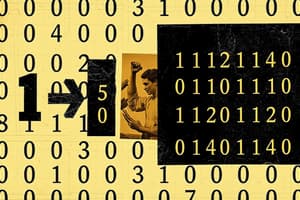Podcast
Questions and Answers
What is the result of adding 1011 and 1111 in binary?
What is the result of adding 1011 and 1111 in binary?
- 10110
- 11010
- 11110
- 10011 (correct)
What is the result of adding 1010 and 1010 in binary?
What is the result of adding 1010 and 1010 in binary?
- 11010
- 10100
- 1100 (correct)
- 10010
What happens when a binary number ends with a 1 and the next digit is 0?
What happens when a binary number ends with a 1 and the next digit is 0?
- The result is undefined
- The carry bit is 0 (correct)
- The carry bit is 1
- There is no carry bit
What is the result of adding 1010 and 1011 in binary?
What is the result of adding 1010 and 1011 in binary?
What is the main principle of binary addition?
What is the main principle of binary addition?
What happens when a binary number ends with a 1 and the next digit is 1?
What happens when a binary number ends with a 1 and the next digit is 1?
What is the result of adding the binary numbers 1011 and 1111?
What is the result of adding the binary numbers 1011 and 1111?
What is the least significant bit (LSB) in a binary number?
What is the least significant bit (LSB) in a binary number?
What is carried over to the next column in binary addition when the result is greater than or equal to 10?
What is carried over to the next column in binary addition when the result is greater than or equal to 10?
What is the decimal equivalent of the binary number 1111?
What is the decimal equivalent of the binary number 1111?
What is the first step in adding two binary numbers?
What is the first step in adding two binary numbers?
What happens when the result in a binary addition column is greater than 9?
What happens when the result in a binary addition column is greater than 9?
Flashcards
Binary Number System
Binary Number System
A number system using only two digits: 0 and 1.
Binary Addition
Binary Addition
The process to sum the values of two binary numbers.
Carry-over in Binary Addition
Carry-over in Binary Addition
If the sum of two bits is 2 (1+1), carry a 1 to the next column.
Least Significant Bit (LSB)
Least Significant Bit (LSB)
Signup and view all the flashcards
Most Significant Bit (MSB)
Most Significant Bit (MSB)
Signup and view all the flashcards
Adding Common Digits
Adding Common Digits
Signup and view all the flashcards
Carry Bit
Carry Bit
Signup and view all the flashcards
1 + 1 in Binary Addition
1 + 1 in Binary Addition
Signup and view all the flashcards
Carry Bit Addition
Carry Bit Addition
Signup and view all the flashcards
Binary to Decimal
Binary to Decimal
Signup and view all the flashcards
Binary Addition Facts
Binary Addition Facts
Signup and view all the flashcards
Carry Over
Carry Over
Signup and view all the flashcards
Study Notes
Binary Number Systems
Binary Addition
Binary number systems are a form of mathematical notation used for numerical representation. They are based on the binary numeral system, which uses only two digits: 0 and 1. The binary system is widely used in digital electronics and computer science, where it is the native language of computers.
Basics of Binary Addition
Binary addition follows the same principles as decimal addition. The larger digit is carried over to the next column if it is greater than or equal to 10. This carry bit is then added to the digit in the next column.
For example, let's consider the binary numbers 1011 (which is equivalent to 11 in decimal) and 1111 (which is equivalent to 15 in decimal). To add these two binary numbers, we follow these steps:
-
Write the binary numbers horizontally, with the least significant bit (LSB) on the right and the most significant bit (MSB) on the left.
1011 +1111 -
Begin the addition process from the rightmost column, starting with the LSB.
1011 +1111 -------- -
In the first column, we have 1 + 1 = 10. Since 10 is greater than 9, we carry the 1 over to the next column.
1011 +1111 -------- 11001 -
In the second column, we have 0 + 1 (carried from the first column) + 1 = 1.
1011 +1111 -------- 11001 -
In the third column, we have 1 + 0 + 1 (carried from the first column) = 2. Since 2 is greater than 9, we carry the 2 over to the next column.
1011 +1111 -------- 11001 -
In the fourth column, we have 1 + 0 + 0 (carried from the first column) = 1.
1011 +1111 -------- 11001 -
We have no further carry bits, so the addition process is complete.
The final result is 10011, which is equivalent to 21 in decimal.
Addition of Binary Numbers with a Common Digit
If two binary numbers have a common digit, it is added just like any other binary digit. For example, let's consider the binary numbers 1010 and 1010.
1010
+ 1010
--------
1100
The final result is 1100, which is equivalent to 12 in decimal.
Carrying Over a 1
If a binary number ends with a 1 and the next digit is 0, the carry bit is 0. For example, let's consider the binary number 1001.
1001
--------
1010
The final result is 1010, which is equivalent to 10 in decimal.
Carrying Over a 1 to the Next Digit
If a binary number ends with a 1 and the next digit is 1, the carry bit is 1. For example, let's consider the binary number 1001.
1001
--------
1100
The final result is 1100, which is equivalent to 12 in decimal.
Addition of Binary Numbers with a Common Digit and a Carry Bit
If two binary numbers have a common digit and a carry bit, the addition process involves adding the carry bit to the digit in the next column, just like any other binary digit. For example, let's consider the binary numbers 1010 and 1011.
1010
--------
1101
The final result is 1101, which is equivalent to 13 in decimal.
In conclusion, binary addition follows the same principles as decimal addition but uses the binary numeral system. The process involves carrying over digits and adding them to the digits in the next column. By understanding the basics of binary addition, we can effectively work with binary numbers in various digital systems.
Studying That Suits You
Use AI to generate personalized quizzes and flashcards to suit your learning preferences.




